
Wine Culture and Information since 2002 - Volume 22
 Wine Culture and Information since 2002 - Volume 22 |
|
Issue 134, November 2014 |
Contents |
|
|
DiWineTaste Mobile for iPhone and iPad |
|
I am very glad to announce, at last, the release of our DiWineTaste Mobile app for iOS devices, therefore iPhone and iPad. The app joins the other one and available since a long time for Android systems and both offer to our readers the very same functions. We in fact tried to develop both apps in order to provide the same look and the same functions both in Android and in iOS, while implementing the respective operative and applicative features of both systems. From reading the magazine to the alcohol test, all the function of our app have been implemented and developed for the iPhone and iPad version. We wish, just like what already happened for the Android version, our readers using iPhone and iPad will appreciate DiWineTaste Mobile. On this regard, we are always glad to listen to your suggestions, feedback and comments. The release of iOS version did not exactly follow the time schedule we planned. A delay not caused by the development itself, indeed because of the natural evolution of the Android version that, of course, forced us to implement the new functions in the iOS version as well. The development of iPhone and iPad version started few months later the release of the Android app and - as it is a young project - usage and time have unavoidably introduced new functions. It was therefore right these new functions to be implemented in the iOS version and, in certain aspects, this forced us to revise and extend the design of the app. As the new functions and features were added to the development, this forced us to continuously update the iPhone and iPas version, therefore we decided to freeze the Android development in order to have a stable and definitive base.
This explains the fact there have not been updates released for the Android app: the project is not over, of course; it is just a development need adopted in order to have two products having the very same features and from which continue the development. Our goal is in fact to keep the Android and iOS versions absolutely the same, in order to ensure a “common path” for both. This means we are working on new functions for the Android version and they will also be implemented in the iOS app. To tell the truth, we also had some other accidents, in particular the breaking of the computer dedicated to the iOS app development and which took some months before it was successfully repaired. It took quite a long time in which they tried to repair the computer and, finally, they decided to completely replace it, while time was going by. In this sense, I am glad to say “so far, so good”. I am of course happy for having finally finished the first part of the development for the iOS app and to have fulfilled the many requests iPhone and iPad users sent us and asking for DiWineTaste Mobile to be released for their devices. I wish their expectations and requests will be satisfied also by the result we achieved and they will find pleasing and handy using our app. I also wish what happened for the Android app and I hope iPhone and iPad users will contribute to the improvement of our app with their suggestions, comments and feedback. We are aware of the fact the iOS app is very young and, unavoidably, there are aspects to be improved or corrected: in this sense, it cannot be different from most of software projects and their development life cycle. I like to think of DiWineTaste Mobile the same way I have always seen my publication: a common project shared with our readers who have always showed us their significant and fundamental support. With the release of iPhone and iPad app we also introduced a minor change in our Wine Guide and Aquavitae. I am sure some readers will have probably noticed wine and distillate forms have slightly changed: we introduced graphic icons for every sensorial aspect in order to make both reading and browsing more immediate and easy. This graphical change is visible in every functional and applicative context of the Guides, the changes are therefore available both in the web version on the site and in both apps. The new graphic look of forms is relative only to those published from September 2014 on, whereas the old ones will not be modified. Our Wine Guide counts more than 4800 wines and the change would certainly require a quite long time. Changes that would be easier in Aquavitae, as it currently counts about 250 distillates. DiWineTaste Mobile for iOS and Android can be respectively and freely downloaded from Apple App Store and Google Play Store. The procedure is the same used for downloading every app, including by searching for it by entering “diwinetaste” in the search key field. The release of the iPhone and iPad app is also a way to celebrate our thirteenth year of activity dedicated to wine and distillates. A new step we add to all the past ones during this amazing journey and which led us here with you all and thank to you all. We wish DiWineTaste Mobile for iPhone, iPad and Android will continue to meet your interest and expectations. The journey goes on. Antonello Biancalana
|
||||||||||||
Multivarietal WinesThe tasting of multivarietal wines introduces a higher complexity than monovarietal ones. An exercise leading to success through practice |
|
Multivarietal wines are produced by blending many grape varieties. Techniques used for their production, we will see this later, are many and in any case they aim to get the same result: creating a wine capable of expressing the sensorial qualities of all the varieties making it. It is not about a practice of wine making alchemy, indeed, it is a compensative technique in order to express a better balance and sensorial complexity in a wine. We can think, for example, of a red variety having an evident crisp and astringent profile, such as Nebbiolo. By adding a variety having a strong round character - such as Merlot - acidity and astringency of Nebbiolo will be attenuated and smoothed according to the respective percentages making the composition. It is not about correcting supposed faults in a variety, indeed it is about creating a new wine having proper sensorial qualities. It should be said production of multivarietal wines is very common all over the world, a practice which can be defined as old as the wine itself. Many of the famous wine areas of the world in fact make wines by blending different varieties, therefore this practice is to be considered absolutely normal, consolidated and common. Many of the great wine areas in the world make wines of this type, such as Bordeaux, Valpolicella and Chianti, as to mention a very short list. Multivarietal wines, for the sake of truth, cannot be considered better than monovarietals. It would be a disputable assertion having no practical and sensorial foundation. None of the two types can in fact be considered better than the other: they are different wine making styles and making different results in qualitative terms. In both cases, they can give from modest and ordinary wines to endlessly great wines. Before discussing the subject of multivarietal wine sensorial tasting, let's try to understand how they are made. The main factor is represented by the presence of two or more grape varieties, usually belonging to the same type - white or red - although this is not an essential and fundamental requirement. We can consider, for example, the “traditional recipe” of Chianti suggested by baron Bettino Ricasoli in which Trebbiano Toscano and Malvasia Bianca are blended to Sangiovese and Canaiolo Nero. A recipe which is rarely used today by the producers of the famous Tuscan wine, although it represented for a very long time an indisputable foundation in Chianti production. In most of the cases it is however the blending of grapes belonging to the same type, therefore white varieties for white wines, red grapes for red wines. The blending of grapes in order to create a unique wine is substantially made by using two distinct methods. The first technique provides for fermenting the must of all grapes in the same container. Grapes, soon after harvesting, are crushed together in order to get a unique must which will then be fermented. The second technique provides for the production of wines from each variety, the resulting wines are then assembled therefore obtaining a unique wine. The second technique is more common than the first one as it allows - as a matter of fact - a better control on the final result by adopting specific procedures and techniques according to each variety. None of the two techniques can be considered better than the other: it all depends on grape varieties used and the type of wines to be produced.
It should in fact be considered each variety get to full ripeness - and therefore usable enologically speaking - in proper times, therefore the technique of fermenting a unique must is used with grapes ripening in the very same period. In case of varieties ripening in different times, blending wines is the preferred method in order to favor the expression of each grape, while respecting biological and wine making needs for each one of them. This consideration is particularly important for red berried grapes, for which it is not considered technological ripeness only - that is the one essentially determined by the quantity of sugar - bust also and in particular for polyphenolic ripeness. For this reason, it is preferred to blend wines in order to let grapes reach their full ripeness - both technological and polyphenolic - in order to get from each of them a qualitatively significant wine. The assembling of each wine is done according to the type of result to be obtained. In certain cases, each wine is blended soon after the fermentation and preliminary stabilization, after that, the whole mass undergoes aging. In other cases, it is preferred to age each wine separately - according to wine making characteristics of each grape - and then to assemble them in order to get a unique wine. This latter case is used when you need to age each wine by using specific techniques or container for each of them. For some grapes it can in fact be decided to age them in steel tanks, whereas for others it can be decided to age them in barrique or cask. This technique favors the keeping of sensorial qualities in those varieties which are not exactly suited for the fermentation or aging in wood and the use of inert container is certainly more beneficial. The study of multivarietal wines certainly is more difficult for the taster than monovarietal ones, as what he or she will be pouring in the glass is the result of the expression of each variety. This means the taster needs to know the characteristics of each grape in order to spot and recognize them in the overall organoleptic profile of the wine. In a sense, it is like trying to recognize someone in a crowd and in which are also found other persons which are eventually known. Of the three phases of sensorial analysis - sight, smell and taste - appearance generally offers a lower number of clues than the other two phases, as color is sometimes deceiving in regard of each variety. It should also be considered wine making techniques could also make things harder for appearance analysis, as the maceration and aging can affect this aspect, even significantly. For this reason, before studying multivarietal wines it is better to focus on monovarietal ones and their different wine making and territorial expressions. The tasting of multivarietal wines follows, in general terms, the same consideration we used so many times in our pages: you cannot recognize something in case you do not know it. For this reason, the study of multivarietal wines follows the study of monovarietal ones in order to get the needed experience and skill in recognizing grape varieties. A good method consists in studying both types at the same time and by using the comparison technique. In this case it should be noticed that, in any case, it is fundamental the knowledge of each variety as we will need the skill of recognizing them in a context made from many grapes. The difficulty of the exercise is of course increased in function of the number of grapes making the multivarietal wine. Let's try to follow this method of study, by starting from white wines and, in particular, the ones produced with aromatic grapes, easier to recognize. In this exercise we will focus on Gewürztraminer grape - famous aromatic variety - which is also blended to other grapes in order to enhance the aromatic profile in a wine. Let's get two wines: one produced with 100% Gewürztraminer, the other one produced with many varieties of which one of them is our aromatic grape. In order to simplify the searching of wines having these characteristics, we can certainly get wines produced in the large North-Eastern part of Italy, an area in which Gewürztraminer is frequently used alone as well as blended to other varieties. It will be better to get wines vinified in inert containers in order to make both the study and tasting easier. To keep simplifying the study, it is better to choose a multivarietal wine made from three grapes and, of them, it is essential Gewürztraminer is the only aromatic grape of the composition. Let's pour the wines in distinct glasses, by paying attention they will be served at the same temperature. Let's start by evaluating aromas of the wine made with Gewürztraminer only while paying attention to its strong aromatic character of grape. Let's now pass to the second wine, and try to recognize the very same grape aromas in its aromatic profile which will probably be more complex. The difficulty in recognizing Gewürztraminer in the second wine is directly proportional to the aromatic qualities of the other grapes. For this reason, in order to simplify the study, the other grapes, despite they however have proper aromatic characteristics, must not belong to the category of aromatic varieties. Gewürztraminer, of course, is not just grape smell. Its olfactory profile is more complex than that, therefore we will continue our study by trying to spot the other nuances of its aromas in the multivarietal wine. From a gustatory point of view, this interesting aromatic grape is pretty recognizable, not only for its pleasing grape flavor, but also for the roundness distinguishing the wines in which it is found. In this case, it should be noticed Gewürztraminer roundness must not be confused with the sensation of sweetness, a quality sometimes deceiving the superficial taster. As we improve our skill, we can proceed with another multivarietal wine and made from a higher number of grapes, including Gewürztraminer. The intensity of this grape will change according to its percentage in the composition and, something not to be taken lightly, according to the production area and wine making characteristics of wine. Te same method can of course be used for the study of multivarietal red wines. Despite there is only one aromatic red variety - Brachetto - this is rarely used for the making of multivarietal wines. We can however proceed with the study by considering very different varieties, such as Sangiovese and Merlot, a pretty common combination in Central Italy. The two grapes have very different characteristics in every sensorial aspect, in particular taste: Sangiovese is crisp and lively, Merlot is more robust and rounder. Also in this case it is better to choose, in the beginning, wines produced in inert containers and then proceed with wines aged and fermented in cask or barrique. The same method of comparative study can be of course applied to every wine style, as the production of multivarietal wines is very common, including in sweet and sparkling wines.
|
||||||||||||
Wines of the Month |
|
|
|
Score legend Prices are to be considered as indicative. Prices may vary according to the country or the shop where wines are bought |
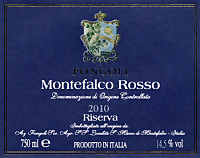
|
|
Montefalco Rosso Riserva 2010 |
|
| Fongoli (Umbria, Italy) | |
 Sangiovese (60%), Sagrantino, Cabernet Franc, Merlot (40%) Sangiovese (60%), Sagrantino, Cabernet Franc, Merlot (40%) | |
| Price: € 18.00 | Score: |
 Intense ruby red with nuances of garnet red, moderate transparency. Intense ruby red with nuances of garnet red, moderate transparency. Intense, clean, pleasing and refined, starts with hints of plum. black
cherry and black currant followed by aromas of dried violet, blackberry,
blueberry, vanilla, tobacco, chocolate and menthol. Intense, clean, pleasing and refined, starts with hints of plum. black
cherry and black currant followed by aromas of dried violet, blackberry,
blueberry, vanilla, tobacco, chocolate and menthol.
 Properly tannic attack, however balanced by alcohol, good body, intense
flavors, pleasing roundness. Properly tannic attack, however balanced by alcohol, good body, intense
flavors, pleasing roundness.
 Persistent finish with flavors of plum, black cherry and black currant. Persistent finish with flavors of plum, black cherry and black currant. Aging for 30 months in cask, 6 months of aging in bottle. Aging for 30 months in cask, 6 months of aging in bottle. |
|
 Roasted meat, Broiled meat and barbecue, Stewed and braised meat, Hard cheese Roasted meat, Broiled meat and barbecue, Stewed and braised meat, Hard cheese |
|
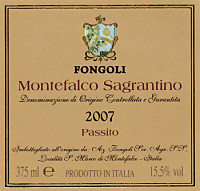
|
|
Montefalco Sagrantino Passito 2007 |
|
| Fongoli (Umbria, Italy) | |
 Sagrantino Sagrantino | |
| Price: € 22.00 - 375ml | Score: |
 Intense ruby red color and nuances of garnet red, little transparency. Intense ruby red color and nuances of garnet red, little transparency. Intense, clean, pleasing and refined, starts with hints of blackberry,
plum and dried violet followed by aromas of black cherry jam, vanilla,
tobacco, chocolate, cinnamon, tamarind and nail polish. Intense, clean, pleasing and refined, starts with hints of blackberry,
plum and dried violet followed by aromas of black cherry jam, vanilla,
tobacco, chocolate, cinnamon, tamarind and nail polish.
 Sweet and tannic attack, however balanced by alcohol, full body,
intense flavors, pleasing roundness. Sweet and tannic attack, however balanced by alcohol, full body,
intense flavors, pleasing roundness.
 Persistent finish with flavors of blackberry, plum and black cherry
jam. Persistent finish with flavors of blackberry, plum and black cherry
jam.
 30 months in cask, 6 months in bottle. 30 months in cask, 6 months in bottle. |
|
 Hard cheese, Chocolate tarts, Jam tarts Hard cheese, Chocolate tarts, Jam tarts |
|

|
|
Fontana del Vescovo 2011 |
|
| Heart of Italy (Umbria, Italy) | |
 Sangiovese (70%), Merlot (30%) Sangiovese (70%), Merlot (30%) | |
| Price: € 12.00 | Score: |
 Intense ruby red and nuances of garnet red, moderate transparency. Intense ruby red and nuances of garnet red, moderate transparency. Intense, clean and pleasing, starts with hints of black cherry, plum
and black currant followed by aromas of violet, blueberry and blackberry. Intense, clean and pleasing, starts with hints of black cherry, plum
and black currant followed by aromas of violet, blueberry and blackberry.
 Properly tannic attack and however balanced by alcohol, good body,
intense flavors, pleasing crispness. Properly tannic attack and however balanced by alcohol, good body,
intense flavors, pleasing crispness.
 Persistent finish with flavors of black cherry, black currant and
blackberry. Persistent finish with flavors of black cherry, black currant and
blackberry.
 Aged for 12 months in steel tanks, 6 months in bottle. Aged for 12 months in steel tanks, 6 months in bottle. |
|
 Pasta with meat and mushrooms, Stewed meat with mushrooms, Sauteed meat Pasta with meat and mushrooms, Stewed meat with mushrooms, Sauteed meat |
|

|
|
Antica Porcellaia 2011 |
|
| Heart of Italy (Umbria, Italy) | |
 Sangiovese Sangiovese | |
| Price: € 18.00 | Score: |
 Brilliant ruby red color and nuances of ruby red, moderate
transparency. Brilliant ruby red color and nuances of ruby red, moderate
transparency.
 Intense, clean, pleasing and refined, starts with hints of black
cherry, plum and violet followed by aromas of raspberry, vanilla,
blueberry, mace, blackberry and menthol. Intense, clean, pleasing and refined, starts with hints of black
cherry, plum and violet followed by aromas of raspberry, vanilla,
blueberry, mace, blackberry and menthol.
 Properly tannic attack, however balanced by alcohol, good body, intense
flavors, agreeable. Properly tannic attack, however balanced by alcohol, good body, intense
flavors, agreeable.
 Persistent finish with flavors of black cherry, plum and raspberry. Persistent finish with flavors of black cherry, plum and raspberry. Aging for 12 months in steel tanks, 12 months in barrique, 6 months in
bottle. Aging for 12 months in steel tanks, 12 months in barrique, 6 months in
bottle.
|
|
 Broiled meat and barbecue, Roasted meat, Stewed meat with mushrooms Broiled meat and barbecue, Roasted meat, Stewed meat with mushrooms |
|

|
|
Valdobbiadene Prosecco Superiore Dry Rive di Col San Martino La Primavera di Barbara 2013 |
|
| Merotto (Veneto, Italy) | |
 Glera (90%), Perera (10%) Glera (90%), Perera (10%) | |
| Price: € 12.00 | Score: |
 Brilliant greenish yellow with nuances of greenish yellow, very
transparent, fine and persistent perlage. Brilliant greenish yellow with nuances of greenish yellow, very
transparent, fine and persistent perlage.
 Intense, clean, pleasing and refined, starts with hints of peach,
wistaria and apple followed by aromas of pear, pineapple, broom, tangerine,
plum and hawthorn. Intense, clean, pleasing and refined, starts with hints of peach,
wistaria and apple followed by aromas of pear, pineapple, broom, tangerine,
plum and hawthorn.
 Crisp and effervescent attack, however balanced by alcohol, good body,
intense flavors, pleasing sweetness. Crisp and effervescent attack, however balanced by alcohol, good body,
intense flavors, pleasing sweetness.
 Persistent finish with flavors of apple, peach and tangerine. Persistent finish with flavors of apple, peach and tangerine. Ferments in closed tank for two months. Ferments in closed tank for two months. |
|
 Risotto with crustaceans, Broiled crustaceans, Vegetable flans Risotto with crustaceans, Broiled crustaceans, Vegetable flans |
|
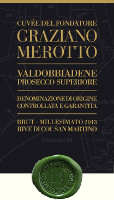
|
|
Prosecco di Valdobbiadene Superiore Brut Rive Col di San Martino Cuvée del Fondatore Graziano Merotto 2013 |
|
| Merotto (Veneto, Italy) | |
 Glera Glera | |
| Price: € 15.00 | Score: |
 Brilliant greenish yellow and nuances of greenish yellow, very
transparent, fine and persistent perlage. Brilliant greenish yellow and nuances of greenish yellow, very
transparent, fine and persistent perlage.
 Intense, clean, pleasing and refined, starts with hints of apple, pear
and peach followed by aromas of broom, tangerine, hawthorn, pineapple,
peach, plum and mineral Intense, clean, pleasing and refined, starts with hints of apple, pear
and peach followed by aromas of broom, tangerine, hawthorn, pineapple,
peach, plum and mineral
 Effervescent and crisp attack, however balanced by alcohol, good body,
intense flavors, agreeable. Effervescent and crisp attack, however balanced by alcohol, good body,
intense flavors, agreeable.
 Persistent finish with flavors of apple, pear and peach. Persistent finish with flavors of apple, pear and peach. Ferments and ages in closed tanks for 6 months. Ferments and ages in closed tanks for 6 months. |
|
 Fish and crustacean appetizers, Sauteed crustaceans, Pasta and risotto with crustaceans Fish and crustacean appetizers, Sauteed crustaceans, Pasta and risotto with crustaceans |
|
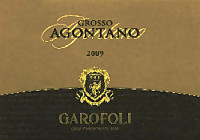
|
|
Conero Riserva Grosso Agontano 2009 |
|
| Garofoli (Marches, Italy) | |
 Montepulciano Montepulciano | |
| Price: € 21.50 | Score: |
 Deep ruby red color and nuances of garnet red, little transparency. Deep ruby red color and nuances of garnet red, little transparency. Intense, clean, pleasing, refined and elegant, starts with hints of
black cherry, plum and blackberry followed by aromas of dried violet,
blueberry, vanilla, chocolate, tobacco, leather, cinnamon, mace, pink
pepper and menthol. Intense, clean, pleasing, refined and elegant, starts with hints of
black cherry, plum and blackberry followed by aromas of dried violet,
blueberry, vanilla, chocolate, tobacco, leather, cinnamon, mace, pink
pepper and menthol.
 Tannic attack, however balanced by alcohol, full bofy, intense flavors,
pleasing roundness. Tannic attack, however balanced by alcohol, full bofy, intense flavors,
pleasing roundness.
 Very persistent finish with long flavors of black cherry, plum and
blackberry. Very persistent finish with long flavors of black cherry, plum and
blackberry.
 18 months in barrique, 12 months in bottle. 18 months in barrique, 12 months in bottle. |
|
 Game, Roasted meat, Stewed and braised meat, Hard cheese Game, Roasted meat, Stewed and braised meat, Hard cheese |
|
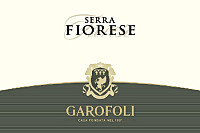
|
|
Verdicchio dei Castelli di Jesi Classico Superiore Riserva Serra Fiorese 2009 |
|
| Garofoli (Marches, Italy) | |
 Verdicchio Verdicchio | |
| Price: € 17.50 | Score: |
 Pale golden yellow and nuances of straw yellow, very transparent. Pale golden yellow and nuances of straw yellow, very transparent. Intense, clean, pleasing, refined and elegant, starts with hints of
apple, plum and citrus fruits followed by aromas of pear, mature peach,
honey, vanilla, grapefruit, pineapple, hawthorn, broom, almond, anise and
mineral. Intense, clean, pleasing, refined and elegant, starts with hints of
apple, plum and citrus fruits followed by aromas of pear, mature peach,
honey, vanilla, grapefruit, pineapple, hawthorn, broom, almond, anise and
mineral.
 Crisp attack, however balanced by alcohol, full body, intense flavors,
pleasing roundness. Crisp attack, however balanced by alcohol, full body, intense flavors,
pleasing roundness.
 Very persistent finish with long flavors of apple, plum and almond. Very persistent finish with long flavors of apple, plum and almond. 12 months in barrique, 12 months in bottle. 12 months in barrique, 12 months in bottle. |
|
 Roasted fish, Roasted white meat, Stewed fish, Stuffed pasta with mushrooms Roasted fish, Roasted white meat, Stewed fish, Stuffed pasta with mushrooms |
|
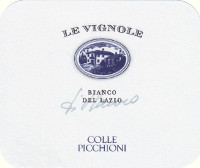
|
|
Le Vignole 2011 |
|
| Colle Picchioni (Latium, Italy) | |
 Malvasia del Lazio (60%), Trebbiano Giallo (20%), Sauvignon Blanc (20%) Malvasia del Lazio (60%), Trebbiano Giallo (20%), Sauvignon Blanc (20%) | |
| Price: € 12.50 | Score: |
 Intense golden yellow and nuances of golden yellow, very transparent. Intense golden yellow and nuances of golden yellow, very transparent. Intense, clean, pleasing, refined and elegant, starts with hints of
quince, plum and honey followed by aromas of hawthorn, pear jam, pineapple,
vanilla, dried apricot, citrus fruits, mature peach, celery and almond. Intense, clean, pleasing, refined and elegant, starts with hints of
quince, plum and honey followed by aromas of hawthorn, pear jam, pineapple,
vanilla, dried apricot, citrus fruits, mature peach, celery and almond.
 Crisp attack, however balanced by alcohol, full body, intense flavors,
pleasing roundness. Crisp attack, however balanced by alcohol, full body, intense flavors,
pleasing roundness.
 Persistent finish with flavors of quince, plum and honey. Persistent finish with flavors of quince, plum and honey. Aged in cask. Aged in cask. |
|
 Stuffed pasta, Roasted white meat, Roasted fish Stuffed pasta, Roasted white meat, Roasted fish |
|
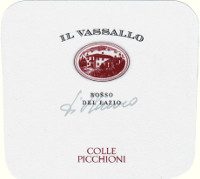
|
|
Il Vassallo 2011 |
|
| Colle Picchioni (Latium, Italy) | |
 Merlot (60%), Cabernet Sauvignon (30%), Cabernet Franc (10%) Merlot (60%), Cabernet Sauvignon (30%), Cabernet Franc (10%) | |
| Price: € 22.00 | Score: |
 intense ruby red color and nuances of ruby red, little transparency. intense ruby red color and nuances of ruby red, little transparency. Intense, clean, pleasing, refined and elegant, starts with hints of
plum, black currant and black cherry followed by aromas of dried violet,
blueberry, vanilla, tobacco, chocolate, mace, graphite and eucalyptus. Intense, clean, pleasing, refined and elegant, starts with hints of
plum, black currant and black cherry followed by aromas of dried violet,
blueberry, vanilla, tobacco, chocolate, mace, graphite and eucalyptus.
 Properly tannic attack, however balanced by alcohol, full body, intense
flavors, pleasing roundness. Properly tannic attack, however balanced by alcohol, full body, intense
flavors, pleasing roundness.
 Persistent finish with flavors of black currant, plum and black cherry. Persistent finish with flavors of black currant, plum and black cherry. Aged for about 12 months in cask and barrique. Aged for about 12 months in cask and barrique. |
|
 Game, Roasted meat, Stewed and braised meat, Hard cheese Game, Roasted meat, Stewed and braised meat, Hard cheese |
|
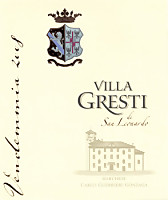
|
|
Villa Gresti 2008 |
|
| Tenuta San Leonardo (Trentino, Italy) | |
 Merlot (90%), Carmenère (10%) Merlot (90%), Carmenère (10%) | |
| Price: € 28.00 | Score: |
 Brilliant ruby red and nuances of garnet red, little transparency. Brilliant ruby red and nuances of garnet red, little transparency. Intense, clean, pleasing, refined and elegant, starts with hints of
black cherry, black currant and violet followed by aromas of blueberry,
raspberry, vanilla, iris, tobacco, pink pepper, chocolate, cinnamon, mace
and face powder. Intense, clean, pleasing, refined and elegant, starts with hints of
black cherry, black currant and violet followed by aromas of blueberry,
raspberry, vanilla, iris, tobacco, pink pepper, chocolate, cinnamon, mace
and face powder.
 Properly tannic attack, however balanced by alcohol, full body, intense
flavors, agreeable. Properly tannic attack, however balanced by alcohol, full body, intense
flavors, agreeable.
 Very persistent finish with long flavors of black cherry, black currant
and blueberry. Very persistent finish with long flavors of black cherry, black currant
and blueberry.
 14 months in barrique, 12 months in bottle. 14 months in barrique, 12 months in bottle. |
|
 Game, Roasted meat, Stewed and braised meat, Hard cheese Game, Roasted meat, Stewed and braised meat, Hard cheese |
|
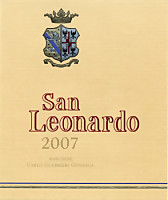
|
|
San Leonardo 2007 |
|
| Tenuta San Leonardo (Trentino, Italy) | |
 Cabernet Sauvignon (60%), Carménère (20%), Cabernet Franc (10%), Merlot (10%) Cabernet Sauvignon (60%), Carménère (20%), Cabernet Franc (10%), Merlot (10%) | |
| Price: € 55.00 | Score: |
 Intense ruby red and nuances of garnet red, little transparency. Intense ruby red and nuances of garnet red, little transparency. Intense, clean, pleasing, refined and elegant, starts with hints of
black currant, black cherry and plum followed by aromas of dried violet,
blueberry, vanilla, tobacco, chocolate, licorice, mace, leather, cigar box,
pink pepper and eucalyptus. Intense, clean, pleasing, refined and elegant, starts with hints of
black currant, black cherry and plum followed by aromas of dried violet,
blueberry, vanilla, tobacco, chocolate, licorice, mace, leather, cigar box,
pink pepper and eucalyptus.
 Tannic attack and however balanced by alcohol, full body, intense
flavors, pleasing roundness. Tannic attack and however balanced by alcohol, full body, intense
flavors, pleasing roundness.
 Very persistent finish with long flavors of black currant, black cherry
and blueberry. Very persistent finish with long flavors of black currant, black cherry
and blueberry.
 24 months in barrique, 12 months in bottle. 24 months in barrique, 12 months in bottle. |
|
 Game, Roasted meat, Stewed and braised meat, Hard cheese Game, Roasted meat, Stewed and braised meat, Hard cheese |
|
News |
|
In this section are published news and information about events concerning the world of wine and food. Whoever is interested in publishing this kind of information can send us a mail to our address.
|
AquavitaeReview of Grappa, Distillates and Brandy |
|
|
| Distillates are rated according to DiWineTaste's evaluation method. Please see score legend in the "Wines of the Month" section. |
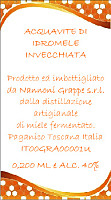
|
|
Acquavite di Idromele di Castagno, Rosmarino e Acacia |
|
| Nannoni (Tuscany, Italy) | |
 Chestnut, Rosemary and Acacia Mead Chestnut, Rosemary and Acacia Mead | |
| Price: € 15.00 - 200ml | Score: |
 Brilliant amber yellow, limpid and crystalline. Brilliant amber yellow, limpid and crystalline. Intense, clean, pleasing and refined with aromas of honey, vanilla,
hazelnut, rosemary and beeswax, with almost imperceptible alcohol pungency. Intense, clean, pleasing and refined with aromas of honey, vanilla,
hazelnut, rosemary and beeswax, with almost imperceptible alcohol pungency.
 Intense flavors and perceptible alcohol pungency which tends to
dissolve rapidly, good correspondence to the nose, pleasing roundness. Intense flavors and perceptible alcohol pungency which tends to
dissolve rapidly, good correspondence to the nose, pleasing roundness.
 Persistent finish with flavors of honey, hazelnut and rosemary. Persistent finish with flavors of honey, hazelnut and rosemary. Distilled in a batch steam operated alembic still and aged for 6 months
in 50 liters wood barrels. Product made by Distilleria Nannoni and
commercialized with its own label by “Villa I Cipressi”. Distilled in a batch steam operated alembic still and aged for 6 months
in 50 liters wood barrels. Product made by Distilleria Nannoni and
commercialized with its own label by “Villa I Cipressi”.
|
|
Wine Parade |
|
|
| The best 15 wines according to DiWineTaste's readers. To express your best three wines send us an E-mail or fill in the form available at our WEB site. |
| Rank | Wine, Producer | |
|---|---|---|
| 1 |
| Sagrantino di Montefalco Collepiano 2007, Arnaldo Caprai |
| 2 |
| Villa Gresti 2006, Tenuta San Leonardo |
| 3 |
| Pelago 2009, Umani Ronchi |
| 4 |
| Amarone della Valpolicella Classico Capitel Monte Olmi 2007, Tedeschi |
| 5 |
| Brunello di Montalcino Vigna Loreto 2007, Mastrojanni |
| 6 |
| Collio Ribolla Gialla L'Adelchi 2012, Venica |
| 7 |
| Maximo 2010, Umani Ronchi |
| 8 |
| I Sodi di San Niccolò 2008, Castellare di Castellina |
| 9 |
| Langhe Riesling Herzu 2011, Ettore Germano |
| 10 |
| Adarmando 2011, Tabarrini |
| 11 |
| Brunello di Montalcino 2007, Donatella Cinelli Colombini |
| 12 |
| Montiano 2011, Falesco |
| 13 |
| Brunello di Montalcino Montosoli 2009, Altesino |
| 14 |
| Verdicchio dei Castelli di Jesi Classico Superiore Podium 2010, Garofoli |
| 15 |
| Torgiano Rosso Riserva Rubesco Vigna Monticchio 2007, Lungarotti |
| |||||||
Privacy Policy | |||||||


| Copyright © 2002-2024 Antonello Biancalana, DiWineTaste - All rights reserved |
| All rights reserved under international copyright conventions. No part of this publication and of this WEB site may be
reproduced or utilized in any form or by any means, electronic or mechanical, without permission in writing from DiWineTaste. |